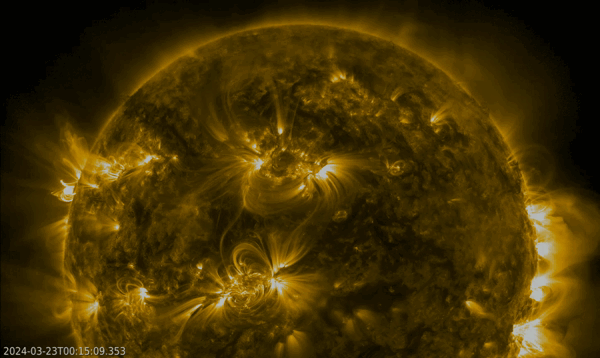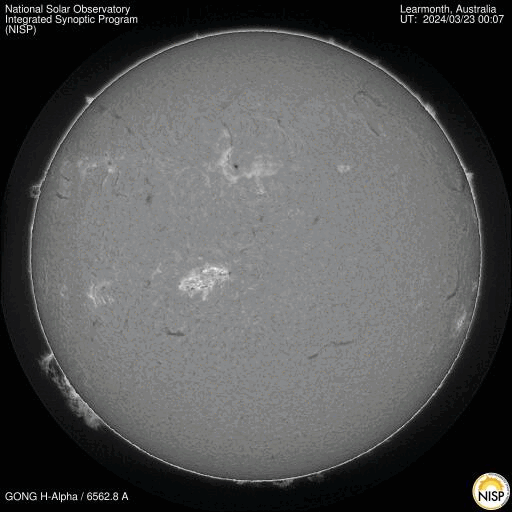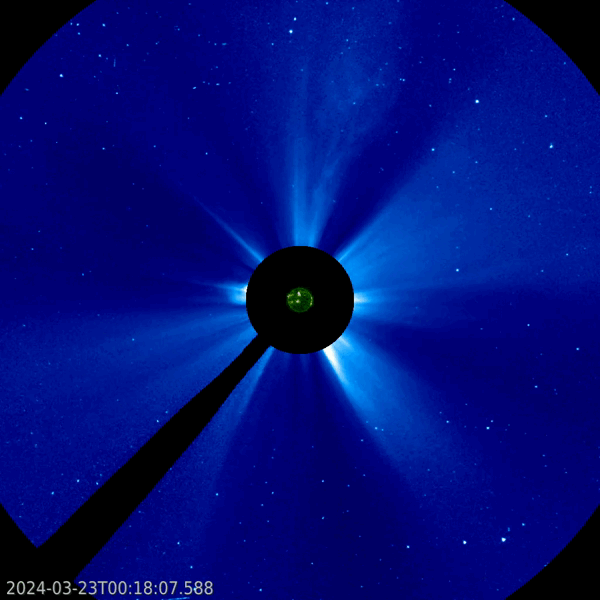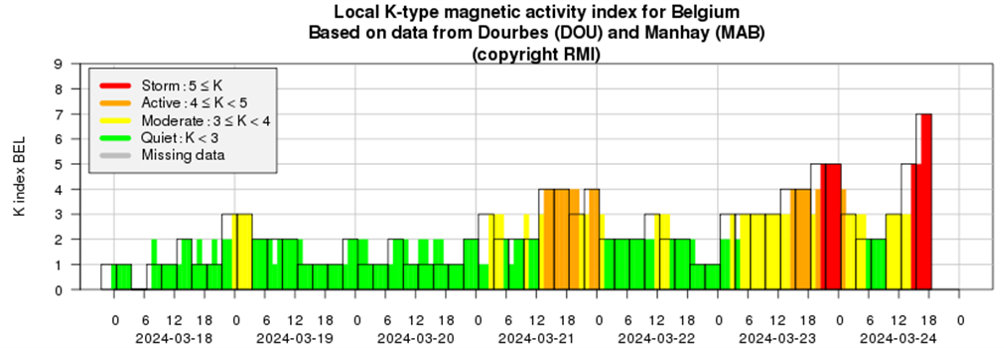UPDATES are added at the end of this newsflash. Please scroll down.
NOAA 3614 is the return of NOAA 3590, the largest sunspot region so far this solar cycle and the source of 3 X-class flares during its previous solar transit (see the discussions in the STCE newsitems here and here). On 23 March, it produced a long-duration X1.1 flare peaking at 01:33UTC. It was accompanied by a strong flare over NOAA 3615, the currently largest and most complex sunspot region on the solar disk: a sympathetic flare (more info on this feature in this STCE newsitem). Also an obvious coronal wave was observed in extreme ultraviolet (EUV) imagery, as well as post-eruption coronal loops ("arcade") and some coronal dimming. The clip underneath shows the eruptions, the coronal wave and the arcade as seen by SDO/AIA 171. Note also the magnetic loops connecting both active regions (pre-event situation in white light and EUV). A clip showing the eruptions at multi-million degrees (AIA 131) is here.

The X-class flare was triggered by the eruption of an unstable filament to the north of NOAA 3614's main spot. This filament has also been the location of a weaker (C5.8) but certainly equally impressive solar flare on 21 March, as shown in this clip at "cold" temperatures of around 80.000 degrees (AIA 304). From the H-alpha images underneath (NSO/GONG - Learmonth), it is clear that this filament has reformed after the X1 eruption and thus may be the source of further strong flaring during the coming days.

Today's strong eruption was associated with a proton event that started at 08:15UTC. It has become the strongest proton event so far this solar cycle, and seems to have reached a maximum of 956 pfu at 18:20UTC. PECASUS has sent several advisories to civil aviation for disturbed High Frequency (3-30 MHz) radio communications resp. on the dayside during the X1 flare, and later during the day for the polar regions as a result of the proton event ("Polar Cap Absorption" ; D-RAP).

Relatively mild radio bursts were recorded at all observed radio frequencies (NOAA/USAF). A type II radio burst (STCE SWx classification page) indicated the presence of a coronal mass ejection (CME), with a shock speed around 790 km/s. A full halo CME was subsequently observed by coronagraphic imagery (SOHO/LASCO) starting at 01:36UTC. Its plane-of-the-sky speed was around 700 km/s (CACTus), its true speed is somewhat higher than this. Hence, the expected arrival time of this CME is most likely 25 March, maybe early 26 March (SIDC SWx forecaster). A moderate and possibly even strong geomagnetic storm is expected (Kp = 6 or 7). According to the NOAA scales, such storms may mildly affect power grids at higher latitudes, may have small charging or drag effects on satellites, and may have impacts on HF communications and GNSS applications, again at higher latitudes. These effects may be more or less pronounced depending on location and time. Polar lights may be visible from 50 to 55 degrees geomagnetic latitude. For Belgium, in case of a strong storm, there's a small chance that aurora can be photographed at dark places.

UPDATE: The interplanetary CME arrived significantly earlier than expected. DSCOVR recorded a jump in the solar wind parameters on 24 March at 14:07UTC. It was followed by a storm sudden commencement recorded by magnetometer stations around the world. Also the Dourbes Geophysical Observatory in Belgium recorded an SSC at 14:37UTC (chart; Intermagnet/BGS). The solar wind speed was at values around 800 km/s. The vertical component of the Interplanetary Magnetic Field (IMF) turned strongly southward and reached -27 nT during the first hour of the ICME passage. The Bz component then turned positive for the subsequent hours. The provisional Kp was at severe levels (8+) during the 15-18UTC interval (Potzdam GFZ), the K-BEL (Dourbes) reported a strong geomagnetic storm during the same interval. As the storm is still in progress, these values can change.
For a severe geomagnetic storm, the NOAA scales indicate that protective systems of power grids at higher latitudes may see some trippings and require some voltage corrections, satellites may suffer from charging or drag effects, and HF communications and GNSS applications may be impacted. This may indeed already be the case for GNSS applications based on the WAAS which shows reduced availability of LPV200 over eastern Canada (Plot). Polar lights may be visible as low as 45 degrees geomagnetic latitude, which for Belgium means there's a small chance that (dim) aurora may be visible at dark places low over the northern horizon. These effects may become more or less pronounced depending on the duration and further evolution of the geomagnetic storm.






